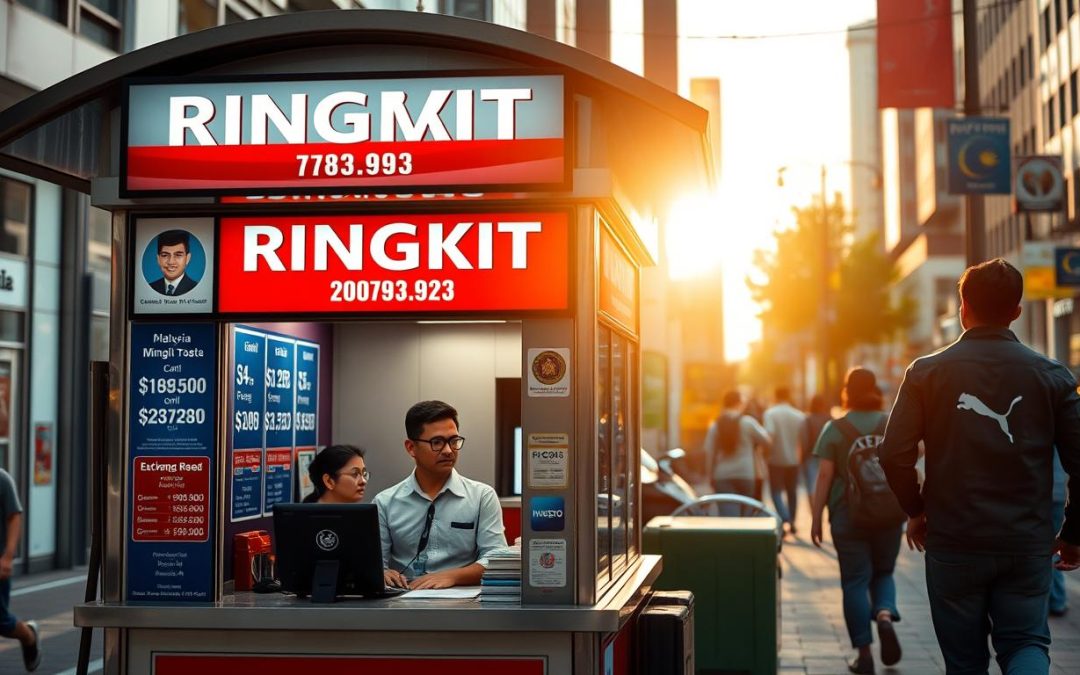Have you ever wondered how much smoother your trip could be if you mastered the local currency and payment methods before arriving? Understanding the monetary system of your destination is not just about convenience—it’s about making the most of your experience. In this guide, we’ll help you navigate the essentials of handling money in Malaysia.
The official currency here is the Malaysian Ringgit (MYR), symbolized as RM. From street markets to high-end hotels, the Ringgit powers every transaction. Knowing the basics, like exchange rates and fees, can save you time and money. Whether you prefer cash, cards, or digital payments, we’ll cover it all.
Ready to feel confident about your financial planning? Let’s dive into the details and ensure you’re well-prepared for your adventure.
Key Takeaways
- The official currency is the Malaysian Ringgit (MYR), symbolized as RM.
- Understanding exchange rates and fees can save you money.
- Cash is widely used, especially for small purchases and tipping.
- ATMs are easily accessible in major cities for withdrawals.
- Using a travel debit card can help avoid foreign transaction fees.
Introduction to Malaysian Currency
Understanding the local currency is the first step to a stress-free trip. The Malaysian Ringgit (MYR) is the official currency, symbolized as RM. Introduced in 1967, it replaced the Malaysian Dollar and has since become a cornerstone of daily transactions.
The Ringgit is divided into 100 sen, with banknotes available in denominations of 1, 5, 10, 20, 50, and 100 RM. Coins are also widely used for smaller purchases. The name “Ringgit” comes from the Malay word for “jagged,” referring to the serrated edges of Spanish silver dollars used in the past.
Exchanging money in Malaysia is straightforward. Banks, ATMs, and licensed money changers are readily available, especially in urban areas. While the Ringgit is a free-floating currency, it’s not traded outside the country, so it’s best to exchange your money locally.
Whether you’re shopping at a bustling market or dining at a hotel, knowing the basics of the Ringgit ensures smooth transactions. Familiarizing yourself with the currency’s structure and exchange process can save you time and avoid unnecessary fees.
By learning about the Malaysian Ringgit, you’re not just preparing for your trip—you’re setting yourself up for a seamless and enjoyable experience.
Malaysia: Ultimate Travelers Guide to Currencies & Payments
Handling money abroad doesn’t have to be stressful—let’s make it simple. Whether you’re exploring bustling markets or dining at a hotel, knowing your options ensures smooth transactions. This guide covers everything you need to manage your finances effectively during your trip.
Cash is widely used, especially for small purchases and tipping. The Malaysian Ringgit (MYR) is the official currency, and having some on hand is always a good idea. ATMs are easily accessible in major cities, but remember, they often require a six-digit PIN.
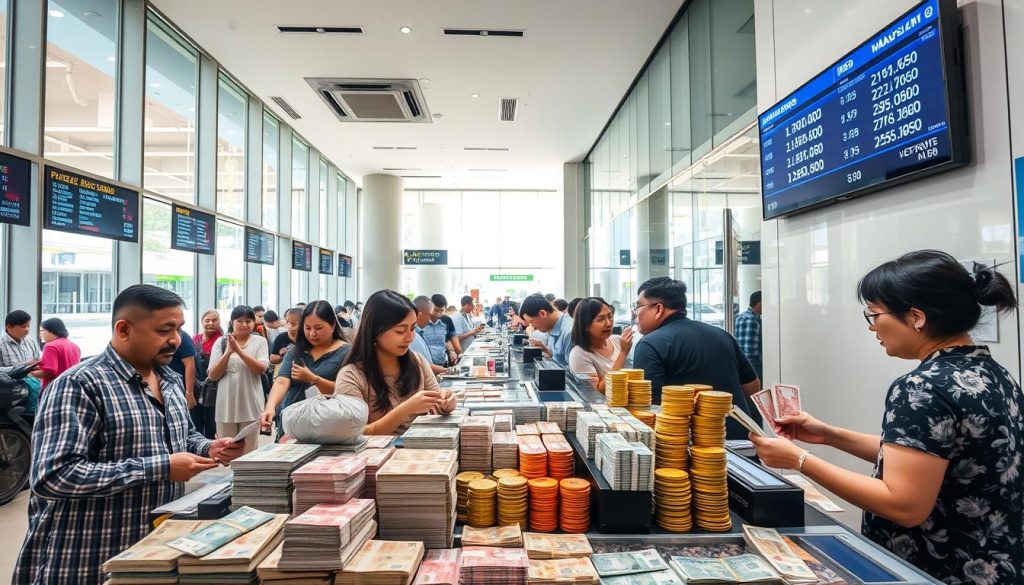
Cards are another convenient option. Many shops, hotels, and restaurants accept credit and debit cards. However, it’s wise to check for foreign transaction fees before using them. Digital payments are also gaining popularity, with apps like GrabPay widely used in urban areas.
Planning ahead can save you from unnecessary fees. Exchange your money at licensed money changers or banks for better rates. Avoid airport exchanges, as they often charge higher fees. By understanding your options, you can make the most of your budget and enjoy a hassle-free trip.
Ready to dive deeper? The next sections will explore exchange rates, ATM withdrawals, and more tips to help you manage your money like a pro.
Understanding Exchange Rates in Malaysia
Getting the best value for your money starts with understanding exchange rates. These rates determine how much of one currency you get for another. For example, the mid-market rate for USD to MYR is currently 0.95385. This rate is the benchmark for fair conversions.
Monitoring the mid-market rate helps you make informed decisions. Banks and money changers often add fees or markups, so knowing the fair rate ensures you don’t overpay. For instance, if you exchange $100, you should receive around 95.39 MYR at the mid-market rate.
Dynamic currency conversion (DCC) is another factor to watch. When paying with a card, you might be asked to pay in your home currency. This often results in poor rates and higher fees. Always choose to pay in the local currency to avoid unnecessary costs.
Online currency converters and bank-provided rates are useful tools. They help you compare rates and find the best deal. Checking live rates before exchanging money can save you a significant amount.
Here’s a quick comparison of exchange rates at different locations:
| Location | USD to MYR Rate | Fees |
|---|---|---|
| Banks | 0.9400 | 2-3% |
| Money Changers | 0.9500 | 1-2% |
| Airport Counters | 0.9300 | 4-5% |
Understanding exchange rates is essential for managing your travel budget. By staying informed, you can avoid overpaying and make the most of your money.
Best Methods for Currency Exchange in Malaysia
Finding the best way to exchange your money can make your trip more enjoyable and stress-free. Whether you’re withdrawing cash or converting foreign currency, understanding your options ensures you get the best value. Let’s explore the most effective methods for handling your finances.
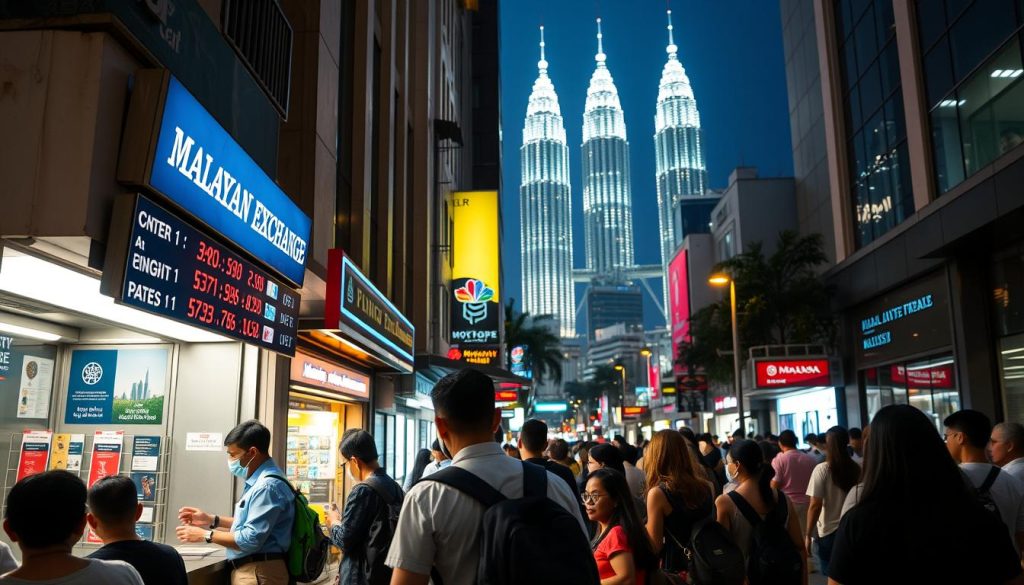
Bank Services vs. Money Changers
Banks are a reliable option for currency exchange. They offer secure transactions and are widely available in urban areas. While their fees might be slightly higher, the peace of mind they provide is worth it. Many banks also offer online services, allowing you to check rates before visiting.
Money changers, on the other hand, are often found in shopping centers and tourist hubs. They provide competitive rates and quick service, making them a popular choice. However, it’s essential to verify their credibility and compare rates to avoid unfavorable deals.
Using ATMs for Convenient Withdrawals
ATMs are a convenient way to access cash during your trip. With over 13,000 ATMs across the country, you’ll find them in major cities and tourist areas. Most ATMs accept international cards, but be aware of withdrawal limits and potential fees.
Here’s a quick comparison of withdrawal options:
| Option | Withdrawal Limit | Fee |
|---|---|---|
| Bank ATMs | RM 1,500 – RM 4,000 | RM 10 – RM 12 |
| Independent ATMs | RM 1,000 – RM 2,000 | RM 8 – RM 10 |
Always check the current exchange rate before making a withdrawal. This ensures you get the most out of your transaction. By choosing the right method, you can save time and money while enjoying your trip.
Using Cards and Digital Payment Solutions
Navigating payments abroad is easier than ever with the rise of digital solutions. Whether you’re shopping, dining, or exploring, knowing your options ensures smooth transactions. This section covers everything you need to confidently use cards and mobile payments during your trip.
Debit and Credit Cards Acceptance
Debit and credit cards are widely accepted in busy urban centers and tourist areas. Most shops, hotels, and restaurants welcome major card networks like Visa and Mastercard. However, it’s essential to check for foreign transaction fees, which typically range from 2% to 4%.
Using a card is convenient, but always have a backup method. Some smaller vendors may only accept cash, especially in rural areas. Inform your bank about your travel plans to avoid declined transactions.
Embracing Mobile and Travel Cards
Mobile payment apps like Apple Pay, GrabPay, and Touch ‘n Go eWallet are gaining popularity. These apps offer quick and secure transactions, making them ideal for everyday purchases. Setting up an account before your trip ensures you’re ready to go.
Travel cards, such as those from Wise or Revolut, are another excellent option. They offer real-time currency conversion and lower fees compared to traditional banks. Here’s a quick comparison of popular travel cards:
| Card | Foreign Transaction Fee | ATM Withdrawal Limit |
|---|---|---|
| Wise | 0.5% | $6,000/month |
| Revolut | 0% (up to £3,000/day) | £3,000/day |
| Chime | 0% | $500/day |
Having a dedicated travel card can save you money and simplify your transactions. Always carry a backup payment method in case of technical issues. By embracing digital solutions, you can enjoy a hassle-free experience while managing your finances efficiently.
Cash is King: Handling Ringgit on the Go
Exploring local markets and small shops often requires having cash on hand. While digital payments are growing, cash remains the most widely accepted form of payment for day-to-day transactions. This is especially true in rural areas and smaller towns, where vendors may not accept cards or mobile payments.
Having sufficient Ringgit ensures you can enjoy everything from street food to unique souvenirs. ATMs are widely available in cities, but in rural areas, they might be harder to find. Plan ahead and withdraw enough cash to cover your needs for a few days.
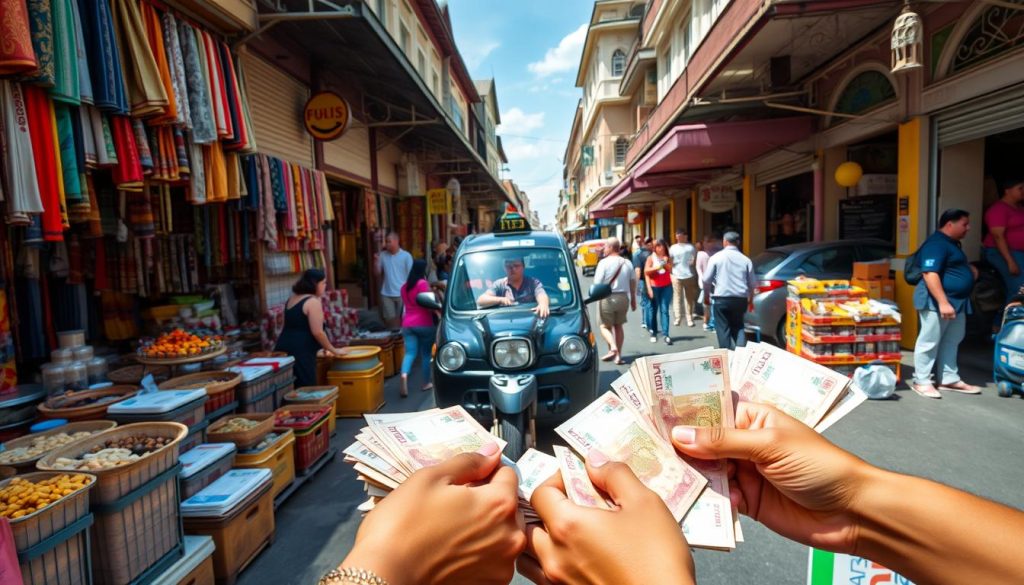
- Carry small denominations for easier transactions, especially in markets.
- Use ATMs in secure locations, like banks or shopping centers, to avoid fees and ensure safety.
- Divide your money into different secure locations, such as a wallet, money belt, or hotel safe.
For example, in bustling markets like Kuala Lumpur’s Central Market, cash is essential for quick purchases. Vendors often prefer it for its simplicity and speed. Even in urban areas, some smaller shops may not accept cards, so having cash ensures you’re always prepared.
Here’s a quick guide to daily cash needs:
| Location | Recommended Cash |
|---|---|
| Cities | RM 50–RM 100 |
| Rural Areas | RM 100–RM 200 |
By managing your cash wisely, you can navigate your trip smoothly and focus on enjoying the experience. Whether you’re haggling at a market or tipping a guide, having the right amount of cash on hand makes all the difference.
Managing Fees and Hidden Costs
Keeping an eye on fees and hidden costs can make a big difference in your travel budget. While it’s easy to focus on exchange rates, overlooking additional charges can add up quickly. By understanding where these costs come from, you can save money and avoid surprises.
Understanding Transaction Fees
Transaction fees are one of the most common hidden costs. Banks and ATM providers often charge fees for withdrawals or currency exchanges. For example, some ATMs may charge a flat fee of RM 10 per withdrawal, while others add a percentage-based fee.
Credit cards can also come with foreign transaction fees, typically ranging from 1% to 3% of the purchase amount. Always check your card’s fee structure before using it abroad. Some travel cards, like Wise or Revolut, offer lower fees and real-time currency conversion, making them a smarter choice.
“Paying in the local currency is always the best way to avoid unnecessary charges.”
Avoiding Dynamic Currency Conversion
Dynamic currency conversion (DCC) is another fee to watch out for. When paying with a card, you might be asked to pay in your home currency instead of the local one. This often results in poor exchange rates and higher fees.
For example, if you’re charged in USD instead of MYR, the conversion rate might be inflated by 3% to 5%. Always choose to pay in the local currency to avoid these extra costs. Most card machines will give you the option, so stay alert during transactions.
Here’s a quick comparison of common fees:
| Service | Fee |
|---|---|
| ATM Withdrawal | RM 8 – RM 12 |
| Foreign Transaction (Credit Card) | 1% – 3% |
| Dynamic Currency Conversion | 3% – 5% |
By researching fee structures and choosing the right payment methods, you can minimize hidden costs. Always compare rates and fees across banks, money changers, and digital services to get the best deal. A little preparation goes a long way in keeping your travel budget intact.
Planning Your Budget for a Malaysia Tour
A well-planned budget helps you make the most of your adventure. Knowing your daily expenses ensures you can enjoy your trip without financial stress. Let’s break down the key areas to consider when planning your spending.
Accommodation costs vary depending on your preferences. Budget hotels start at around $25 per night, while mid-range options average $74. For luxury stays, expect to pay $238 or more. Booking in advance can save you money, especially during off-peak seasons.
Food is another essential part of your budget. Street food and local markets offer meals for as little as $1 to $3 per dish. Mid-range restaurants charge around $31 per day, while fine dining can cost $91 or more. Trying local eateries not only saves money but also adds authenticity to your experience.
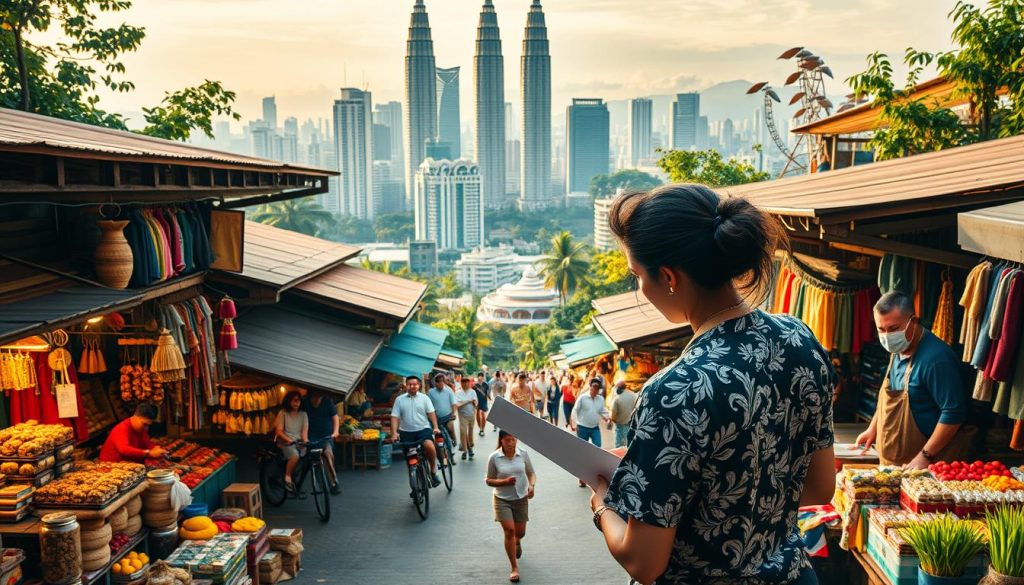
Transportation is affordable, with public transit fares starting at $0.30. For sightseeing, attractions like the Langkawi SkyCab cost around $10, while temple entry fees are often under $1. Group discounts are common, so traveling with others can reduce costs.
Exchange rates play a significant role in budget planning. For example, 1 USD equals approximately 4.72 MYR. Monitoring rates helps you get the best value for your money. Always compare rates at banks or licensed money changers to avoid unnecessary fees.
Balancing cash and card usage is crucial. While cards are convenient for larger purchases, cash is essential for smaller vendors and markets. Carry small denominations for easier transactions and divide your money between a wallet and a secure location like a hotel safe.
Finally, set aside a contingency fund for unexpected expenses. Aim for 10-15% of your total budget as a safety net. Researching recent traveler reports and local tips can help you tailor your budget to your needs.
By planning ahead and understanding your spending needs, you can enjoy a seamless and memorable trip. A well-structured budget ensures you focus on exploring, not worrying about finances.
Tips for Currency Safety and Convenience
Ensuring your money stays safe while traveling is just as important as managing it wisely. A few simple steps can help you avoid common pitfalls and keep your finances secure. Let’s explore practical tips to protect your currency and cards during your trip.
Informing Your Bank Ahead
Before you leave, notify your bank about your travel plans. This prevents your cards from being flagged for suspicious activity and blocked. Many banks allow you to set travel notifications online or through their app. It’s a quick step that can save you from unexpected disruptions.
Also, check your card’s international usage policies. Some cards charge foreign transaction fees, while others offer fee-free spending abroad. Knowing these details helps you choose the best payment method for your needs.
Securing Your Money While Traveling
Carrying cash is essential, but it’s important to do so safely. Use a money belt or RFID-protected wallet to keep your valuables secure. These tools prevent theft and unauthorized scanning of your cards.
Divide your money between different locations. For example, keep some cash in your wallet, some in a hidden pouch, and the rest in your hotel safe. This way, you’re prepared even if one stash is lost or stolen.
- Monitor your card activity online or through your bank’s app. Set up alerts for transactions to spot any unauthorized charges quickly.
- Avoid displaying large amounts of cash in public. Use discreet methods like a small wallet or pouch for daily expenses.
- Consider using a travel card or digital payment app as a backup. These options reduce the need to carry large amounts of cash.
In busy tourist areas, stay vigilant. Pickpockets often target distracted travelers. Keep your belongings close and avoid leaving bags unattended. By following these tips, you can enjoy your trip with confidence and peace of mind.
Local Payment Practices and Tipping Culture
Navigating local payment customs can enhance your travel experience and foster positive interactions. While tipping isn’t mandatory, it’s appreciated for exceptional service. Understanding these practices helps you show gratitude appropriately and build rapport with locals.
When and How to Tip
In restaurants, a 10% service charge is often included in the bill. If not, leaving an additional 10-15% is a kind gesture. For hotel staff, such as porters or housekeeping, a tip of RM2 to RM10 is customary for good service.
Tour guides and drivers also appreciate tips. For private tours, RM20 to RM30 per person is common, while group tours may warrant around 10% of the total cost. Taxi drivers, especially on longer trips, often receive a 10% tip, particularly if they assist with luggage.
Negotiating Prices in Local Markets
Bargaining is a common practice in local markets, especially in tourist areas like Kuala Lumpur or Penang. Vendors often expect some negotiation, so don’t hesitate to politely counter their initial offer. Cash is the preferred method for these transactions, as it simplifies the process.
Here are a few tips for successful negotiation:
- Start by offering 50-70% of the asking price and work your way up.
- Maintain a friendly and respectful tone throughout the conversation.
- Be prepared to walk away if the price doesn’t meet your budget—vendors may call you back with a better offer.
For example, in bustling markets like Central Market Kuala Lumpur, vendors often price items higher for tourists. A polite negotiation can lead to a fair deal for both parties.
Cash is Key for Small Transactions
While digital payments are growing, cash remains essential for small purchases and tipping. ATMs are widely available in cities, but in rural areas, they might be harder to find. Plan ahead and withdraw enough cash to cover your needs for a few days.
| Service | Suggested Tip |
|---|---|
| Restaurants | 10-15% of the bill |
| Hotel Staff | RM2 – RM10 |
| Tour Guides | RM20 – RM30 per person |
| Taxi Drivers | 10% of the fare |
By understanding local payment practices and tipping culture, you can navigate your trip with confidence and respect. Whether you’re dining out, shopping, or exploring, these insights ensure smooth and positive interactions.
Conclusion
With the right financial strategies, your journey can be both seamless and enjoyable. Understanding exchange rates and managing fees ensures you get the most out of your budget. Always carry a mix of cash and cards to cover all your needs, from markets to restaurants.
Don’t forget to inform your bank before traveling to avoid declined transactions. Digital payment tools like travel cards or apps can simplify your experience and reduce unnecessary costs. These options are especially useful in urban areas.
Embrace local customs like tipping and bargaining to enhance your interactions. A little preparation goes a long way in making your trip smooth and memorable. By following these tips, you’ll feel confident and ready to explore.
For more detailed insights, continue researching and planning. This guide aims to be your go-to resource for managing finances abroad. Safe travels and enjoy your adventure!
The above is subject to change.
Check back often to TRAVEL.COM for the latest travel tips and deals.
Here are some Tours & Sightseeing suggestions that might pique your interests!
